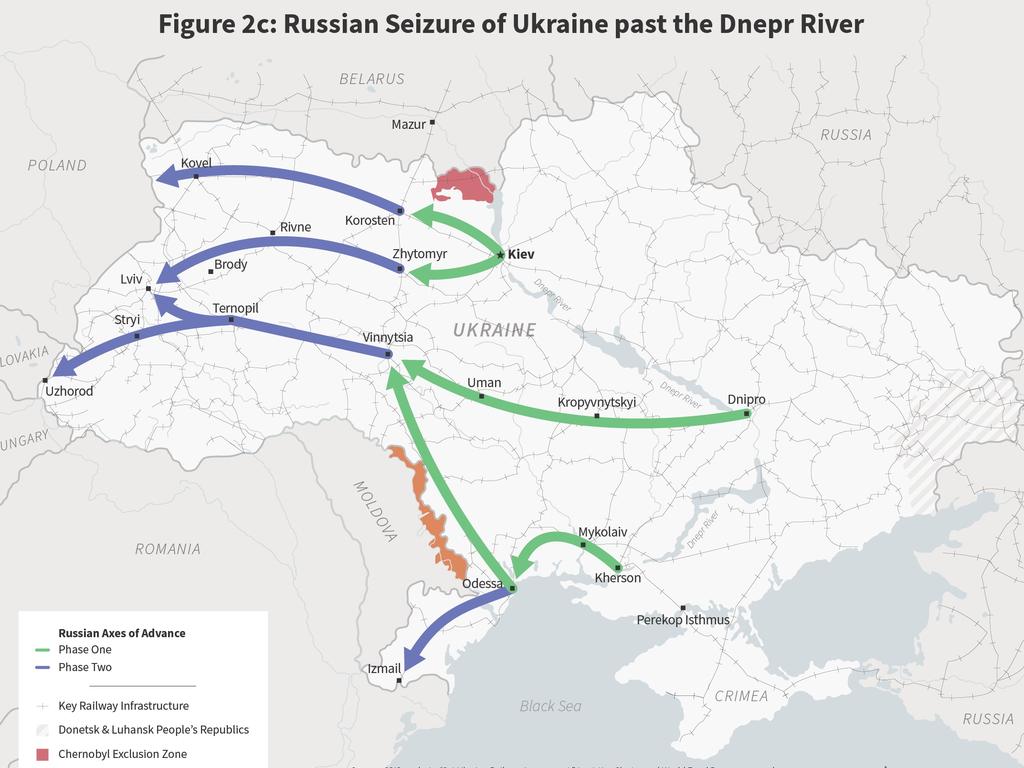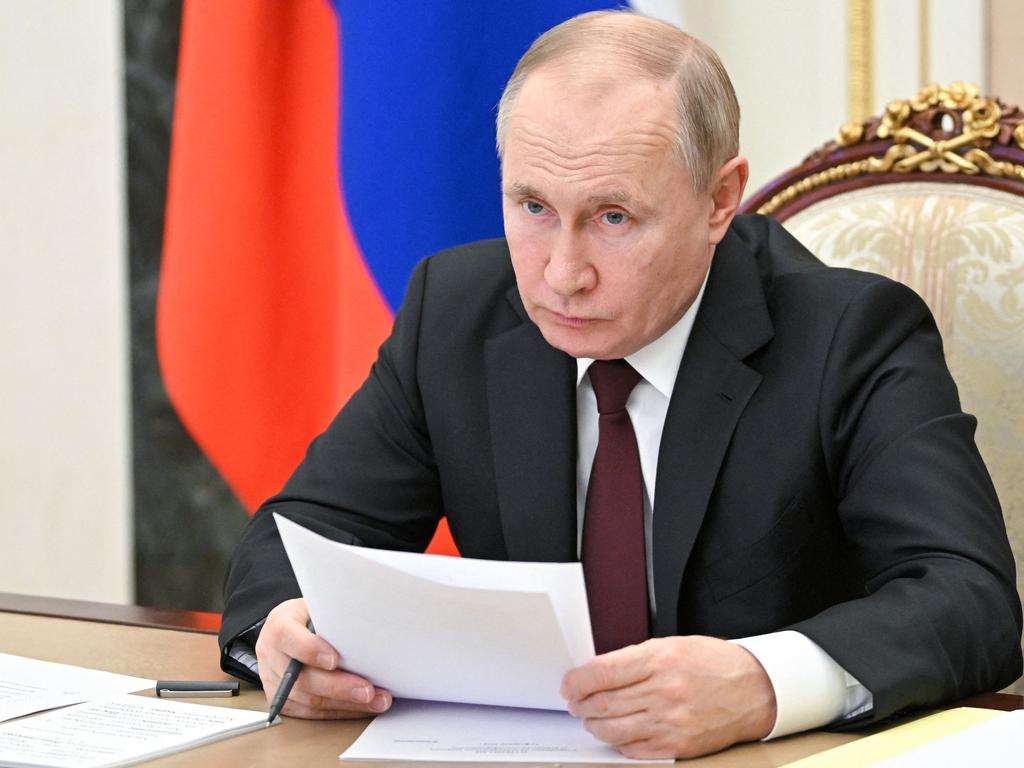What Russian invasion of Ukraine would look like
The US says Russia is in the early stages of an invasion of Ukraine. And the conflict shows no signs of being resolved.

The US says the early stages of a Russian invasion of Ukraine are “unfolding right now” – so what happens next?
Secretary of State Antony Blinken told a United Nations Security Council meeting in New York on Thursday that Moscow had bolstered its forces along the borders of the two nations in recent days and was preparing to “launch an attack”.
“In fact, it’s unfolding right now, today, as Russia takes steps down the path to war and reissued the threat of military action,” said Mr Blinken, who described the unfolding crisis as a “moment of peril for the lives and safety of millions of people”.
“I am here today not to start a war, but to prevent one,” he said. “The information I presented here is validated by what we’ve seen unfolding in plain sight before our eyes for months.”
America’s top diplomat said despite Russia’s dismissal of the West’s claims, it had amassed more than 100,000 troops on Ukraine’s borders and the “capabilities to conduct a massive military assault”.
Australia’s Defence Minister Peter Dutton has echoed those comments, saying reports of a shelled kindergarten were “very concerning”.
“It’s a dire situation and on every indication that we’re seeing at the moment you would expect Russia is in the early stages of that invasion, of that incursion,” he told Sky News Australia on Friday.
It came after President Joe Biden told reporters outside the White House earlier that Russia was “engaged in a false flag operation to have an excuse to go in”, describing the threat of invasion as “very high”.

What would a Russian invasion of Ukraine look like?
The UK Ministry of Defence on Thursday outlined the possible “axis of invasion”, sharing a map and presentation on social media.
“An invasion could happen within days,” the narrator says, as an animated map shows the path Russian forces could take.
Last month, the Center for Strategic and International Studies also laid out the possible course of a Russian invasion of Ukraine.
INTELLIGENCE UPDATE: We have seen no evidence that Russian forces are withdrawing from Ukrainian border regions.
— Ministry of Defence 🇬🇧 (@DefenceHQ) February 17, 2022
Russia retains a significant military presence that can conduct an invasion without further warning. pic.twitter.com/qTYrItLxCf
The Washington-based think tank’s analysis, authored by retired CIA officer Philip Wasielewski and Seth Jones, director of the international security program at CSIS, described at least three possible axes of advance if Russia decides to seize Ukrainian territory.
“A northern thrust, possibly attempting to outflank Ukrainian defences around Kyiv by approaching through Belarus, a central thrust advancing due west into Ukraine, and a southern thrust advancing across the Perekop isthmus,” they wrote.
President Vladimir Putin’s primary goal is an end to NATO expansion on Russia’s doorstep, with the Kremlin seeking guarantees that Belarus, Ukraine, and Georgia will never join the security bloc.
Moscow wants an exclusive sphere of influence over Eastern Europe and the South Caucasus – the area covering Armenia, Georgia, and Azerbaijan – to meet its security interests, and has vowed to use military force to protect those interests.

Based on Russia’s stated political goals, the CSIS report lays out six possible military options:
1. Redeploy some of its ground forces away from the Ukrainian border — at least temporarily — if negotiations are successful but continue to aid pro-Russian rebels in Eastern Ukraine.
2. Send conventional Russian troops into the breakaway regions of Donetsk and Luhansk as unilateral ‘peacekeepers’ and refuse to withdraw them until peace talks end successfully and Kyiv agrees to implement the Minsk Accords.
3. Seize Ukrainian territory as far west as the Dnepr River to use as a bargaining chip or incorporate this new territory fully into the Russian Federation. This option is represented in Figure 2a.
4. Seize Ukrainian territory up to the Dnepr River and seize an additional belt of land (to include Odessa) that connects Russian territory with the breakaway Transdniestria Republic and separates Ukraine from any access to the Black Sea. The Kremlin would incorporate these new lands into Russia and ensure that the rump Ukrainian statelet remains economically unviable.
5. Seize only a belt of land between Russia and Transdniestria (including Mariupol, Kherson, and Odessa) to secure freshwater supplies for Crimea and block Ukraine’s access to the sea, while avoiding major combat over Kyiv and Kharkiv. This option is represented in Figure 2b.
6.Seize all of Ukraine and, with Belarus, announce the formation of a new tripartite Slavic union of Great, Little, and White Russians (Russians, Ukrainians, and Belarusians). This option would involve operations represented in Figure 2a as ‘phase one’, with Figure 2c representing ‘phase two’ of this option.



The authors argue that the first two options would be least likely to incur significant international sanctions but would be unlikely to achieve Russia’s goals.
On the other hand, all other options would cause major backlash on the world stage and be “counter-productive” to the goal of weakening NATO as they would harden the resolve of the US and its European allies.
The most drastic, option six, would entail “dealing with the assimilation of a population of 41 million that may resist occupation actively and passively for years”.
“It would require an occupation force of considerable size to control the population and man the new borders with NATO countries,” they wrote.
“Ukrainians in any occupied territory can expect forced Russification that the nation experienced under such rulers as Catherine the Great, Alexander II, Stalin, and Brezhnev.”

Cyberattacks followed by aerial bombardment
Once Moscow has established a casus belli, or justification for war, it will launch cyberattacks against Ukraine’s military command-and-control systems and public communications and electrical grids.
“Next, kinetic operations will likely begin with air and missile strikes against Ukraine’s air force and air defence systems,” they wrote.
“Once air superiority is established, Russian ground forces would move forward, slightly preceded by special operations to degrade further command and control capabilities and delay the mobilisation of reserves by conducting bombings, assassinations, and sabotage operations.”
All of the potential invasion routes except the coastal one parallel existing rail lines.
“This is essential since Russian army logistics forces are not designed for large-scale ground offensives far from railroads,” they wrote.
“If Russia’s objectives include denying Ukraine future access to the sea, it will have to seize Odessa. Some predict that this would be accomplished via amphibious and airborne landings near Odessa, which link up with mechanised forces approaching from the east.
“If Russia intends to conquer the entire country, its forces would need to seize Odessa (whose port facilities would ease Russian logistics) and also cross the Dnepr River at several points to march and fight an additional 350 to 700 miles (560 to 1130 kilometres) further west to occupy all of Ukraine up to its borders with Poland, Slovakia, Hungary, Romania, and Moldova.”
Overall, a combination of weather, local resistance, logistics difficulties, Russian morale and Western interventions pose significant challenges to Russia’s prospects of success, despite its military advantage over Ukraine.
But “with enough troops, firepower, logistics, time, and national will, as well as no outside interference, Russia could grind forward until its military achieves the Kremlin’s political objectives”.

Russia could maintain ‘blockade’ for years
Even if Russia doesn’t invade, it may use the massive armoured force to maintain what is effectively a blockade for months or even years, the head of Ukraine’s diplomatic mission in Australia, Volodymyr Shalkivskyi, told the Australian Strategic Policy Institute’s The Strategist.
“Two, three or five months of such pressure will be devastating for our economy,” he said.
Mr Shalkivskyi said Russia’s forces, which could reach 150,000, were enough to attack Ukraine but not to occupy it.
“It’s not enough to control 40-plus million people in a country the size of New South Wales,” he said.
He said after months of sabre-rattling, backing down without losing face domestically would be difficult for Mr Putin.
“There is no easy way out, but nobody wants full-scale war,” Mr Shalkivskyi said.
“Putin has to bring some kind of glorious achievement for internal consumption, but he has time. He can wait. And there is no indication so far that he’s pulling back the troops.”






